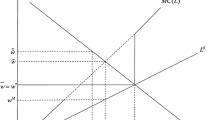Abstract
This paper deals with the problem of finding optimal hiring/firing and wage policies for a profit-maximizing monopolistic firm. The crucial assumptions of the model are convex shortage costs permitting shortages in output capacity, nonlinear hiring and firing costs, and the wage rate as control variable being restricted by a minimal level. Due to the nonsmoothness of the revenue function occurring in the objective functional, a generalized maximum principle is required to analyze the optimal control problem. The resulting phase-diagram analysis provides an insight into the optimal recruitment, wage, and pricing policies.
Similar content being viewed by others
References
Latham, R. W., andPeel, D. A.,Adjustment Costs and Short-Run Returns to Labour, Review of Economics and Statistics, Vol. 56, pp. 393–396, 1974.
Nickell, S. J.,Fixed Costs, Employment, and Labor Demand over the Cycle, Economica, Vol. 45, pp. 329–345, 1978.
Feichtinger, G.,Optimal Employment Strategies of Profit-Maximizing and Labor-Managed Firms, Optimal Control Applications and Methods, Vol. 5, pp. 235–253, 1984.
Salop, S. C.,Wage Differentials in a Dynamic Theory of the Firm, Journal of Economic Theory, Vol. 6, pp. 321–344, 1973.
Leban, R., andLesourne, J.,The Firm's Investment and Employment Policy through a Business Cycle, European Economic Review, Vol. 13, pp. 43–80, 1980.
Leban, R.,Employment and Wage Strategies of the Firm over a Business Cycle, Journal of Economic Dynamics and Control, Vol. 4, pp. 371–394, 1982.
Leban, R.,Wage Rigidity and Employment Policy of the Firm in a Dynamic Environment, Optimal Control Theory and Economic Analysis, Edited by G. Feichtinger, North-Holland, Amsterdam, Holland, 1982.
Clarke, F. H.,The Maximum Principle under Minimal Hypotheses, SIAM Journal on Control and Optimization, Vol. 14, pp. 1078–1091, 1976.
Clarke, F. H.,Optimal Control and the True Hamiltonian, SIAM Review, Vol. 21, pp. 157–166, 1979.
Hartl, R. F., andSethi, S. P.,Optimal Control Problems with Differential Inclusions: Sufficiency Conditions and an Application to a Production-Inventory Model, Optimal Control Applications and Methods, Vol. 5, pp. 289–307, 1984.
Holt, C. C., Modigliani, F., Muth, J. F., andSimon, H. A.,Planning Production, Inventories, and Work Force, Prentice-Hall, Englewood Cliffs, New Jersey, 1960.
Phelps, E. S., andWinter, S. G., Jr,Optimal Price Policy under Atomistic Competition, Micro-Economic Foundations of Employment and Inflation Theory, Edited by E. S. Phelpset al., Macmillan, New York, New York, 1970.
Luptacik, M.,Optimal Price and Advertising Policy under Atomistic Competition, Journal of Economic Dynamics and Control, Vol. 4, pp. 57–71, 1982.
Feichtinger, G.,Saddle Point Analysis in a Price-Advertising Model, Journal of Economic Dynamics and Control, Vol. 4, pp. 319–340, 1982.
Sethi, S. P., andThompson, G. L.,Optimal Control Theory: Applications to Management Science, M. Nijhoff, Boston, Massachusetts, 1981.
Kamien, M. I., andSchwartz, N. L.,Dynamic Optimization: The Calculus of Variations and Optimal Control in Economics and Management, North-Holland, New York, New York, 1981.
Nerlove, M., andArrow, K. J.,Optimal Advertising Policy under Dynamic Conditions, Economica, Vol. 39, pp. 129–142, 1962.
Gould, J. P.,Diffusion Process and Optimal Advertising Policy, Microeconomic Foundations of Employment and Inflation Theory, Edited by E. S. Phelpset al., New York, New York, 1970.
Feichtinger, G.,On the Synergistic Influence of Two Control Variables on the State of Nonlinear Optimal Control Models, Journal of the Operation Research Society, Vol. 35, pp. 907–914, 1984.
Feichtinger, G., andSteindl, A.,Lagerhaltungs- und Beschäftigungs-strategien einer Firma, OR Spektrum, Vol. 6, pp. 93–107, 1984.
Long, N. V., andSiebert, H.,Lay-Off Restraints, Employment Subsidies, and the Demand for Labor, Optimal Control Theory and Economic Analysis, Vol. 2, Edited by G. Feichtinger, North-Holland, Amsterdam, Holland, 1985.
Author information
Authors and Affiliations
Additional information
Communicated by G. Leitmann
The authors would like to thank R. Hartl, E. Fehr, F. Hof, S. Jørgensen, R. Leban, N. Van Long, and R. Neck for helpful suggestions and comments to this and earlier versions of the paper.
Rights and permissions
About this article
Cite this article
Feichtinger, G., Luptacik, M. Optimal employment and wage policies of a monopolistic firm. J Optim Theory Appl 53, 59–83 (1987). https://doi.org/10.1007/BF00938817
Issue Date:
DOI: https://doi.org/10.1007/BF00938817




